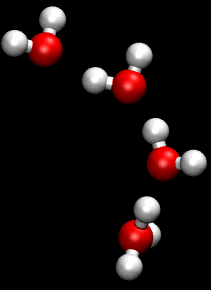Grotthuss mechanism

The Grotthuss mechanism (also known as proton jumping) is the process by which an 'excess' proton or proton defect diffuses through the hydrogen bond network of water molecules or other hydrogen-bonded liquids through the formation and concomitant cleavage of covalent bonds involving neighboring molecules.
In his 1806 publication “Theory of decomposition of liquids by electrical currents”, Theodor Grotthuss proposed a theory of water conductivity.[1] Grotthuss envisioned the electrolytic reaction as a sort of ‘bucket line’ where each oxygen atom simultaneously passes and receives a single hydrogen ion. It was an astonishing theory to propose at the time, since the water molecule was thought to be OH not H2O and the existence of ions was not fully understood. On its 200th anniversary, his article was reviewed by Cukierman.[2]
Although Grotthuss was using an incorrect empirical formula of water, his description of the passing of protons through the cooperation of neighboring water molecules proved prescient.
Lemont Kier suggested that proton hopping may be an important mechanism for nerve transduction.[3]
Proton transport mechanism and proton-hopping mechanism[]
The Grotthuss mechanism is now a general name for the proton-hopping mechanism. In liquid water the solvation of the excess proton is idealized by two forms: the H9O4+ (Eigen cation) or H5O2+ (Zundel cation). While the transport mechanism is believed to involve the inter-conversion between these two solvation structures, the details of the hopping and transport mechanism is still debated. Currently there are two plausible mechanisms:
- Eigen to Zundel to Eigen (E–Z–E), on the basis of experimental NMR data,[4]
- Zundel to Zundel (Z–Z), on the basis of molecular dynamics simulation.
The calculated energetics of the hydronium solvation shells were reported in 2007 and it was suggested that the activation energies of the two proposed mechanisms do not agree with their calculated hydrogen bond strengths, but mechanism 1 might be the better candidate of the two.[5]
By use of conditional and time-dependent radial distribution functions (RDF), it was shown that the hydronium RDF can be decomposed into contributions from two distinct structures, Eigen and Zundel. The first peak in g(r) (the RDF) of the Eigen structure is similar to the equilibrium, standard RDF, only slightly more ordered, while the first peak of the Zundel structure is actually split into two peaks. The actual proton transfer (PT) event was then traced (after synchronizing all PT events so that t=0 is the actual event time), revealing that the hydronium indeed starts from an Eigen state, and quickly transforms into the Zundel state as the proton is being transferred, with the first peak of g(r) splitting into two.[6]
The anomalous diffusion of protons[]
The Grotthuss mechanism, along with the relative lightness and small size (ionic radius) of the proton, explains the unusually high diffusion rate of the proton in an electric field, relative to that of other common cations (Table 1) whose movement is due simply to acceleration by the field. Random thermal motion opposes the movement of both protons and other cations. Quantum tunnelling becomes more probable the smaller the mass of the cation is, and the proton is the lightest possible stable cation.[citation needed] Thus there is a minor effect from quantum tunnelling also, although it dominates at low temperatures only.
| Cation | Mobility / cm2 V−1 s−1 |
| NH4+ | 0.763×10−3 |
| Na+ | 0.519×10−3 |
| K+ | 0.762×10−3 |
| H+ | 3.62×10−3 |
References[]
- ^ de Grotthuss, C.J.T. (1806). "Sur la décomposition de l'eau et des corps qu'elle tient en dissolution à l'aide de l'électricité galvanique". Ann. Chim. 58: 54–73.
- ^ Cukierman, Samuel (2006). "Et tu Grotthuss!". Biochimica et Biophysica Acta. 1757 (8): 876–8. doi:10.1016/j.bbabio.2005.12.001. PMID 16414007.
- ^ Kier, Lemont B. (2016). "Proton Hopping as the Nerve Conduction Message". Current Computer-Aided Drug Design. 12 (4): 255–258. doi:10.2174/1573409912666160808092011. ISSN 1875-6697. PMID 27503744.
- ^ Agmon, Noam (1995). "The Grotthuss mechanism". Chem. Phys. Lett. 244 (5–6): 456–462. Bibcode:1995CPL...244..456A. doi:10.1016/0009-2614(95)00905-J. Archived from the original on 2011-07-19. Retrieved 2007-04-10.
- ^ Markovitch, Omer; Agmon, Noam (2007). "Structure and energetics of the hydronium hydration shells". J. Phys. Chem. A. 111 (12): 2253–6. Bibcode:2007JPCA..111.2253M. CiteSeerX 10.1.1.76.9448. doi:10.1021/jp068960g. PMID 17388314.
- ^ Markovitch, Omer; et al. (2008). "Special Pair Dance and Partner Selection: Elementary Steps in Proton Transport in Liquid Water". J. Phys. Chem. B. 112 (31): 9456–9466. doi:10.1021/jp804018y. PMID 18630857.
External links[]
- Roberts, Sean T.; et al. (2011). "Proton Transfer in Concentrated Aqueous Hydroxide Visualized Using Ultrafast Infrared Spectroscopy" (PDF). The Journal of Physical Chemistry A. 115 (16): 3957–3972. Bibcode:2011JPCA..115.3957R. doi:10.1021/jp108474p. hdl:1721.1/69657. PMID 21314148.
- H. L. Friedman, Felix Franks, Aqueous Symple Electrolytes Solutions
- Water chemistry
- Acid–base chemistry